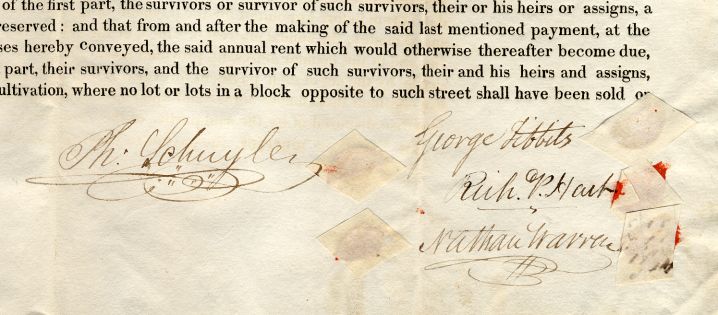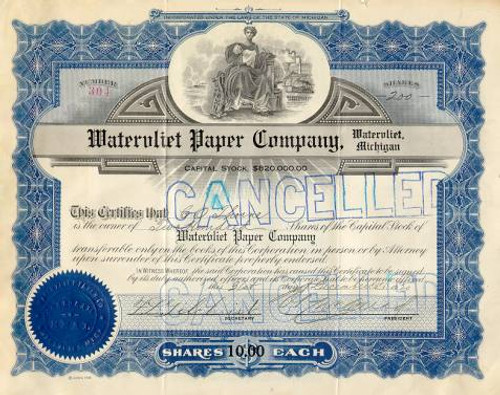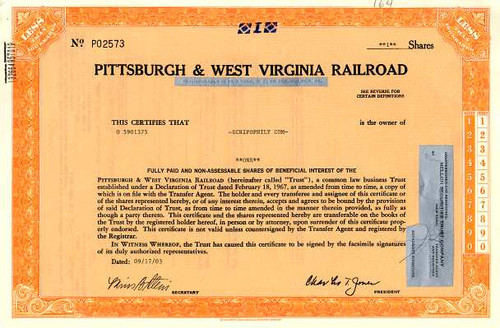Land Sales Contract relating to the West Troy Company signed by George Tibbits, Nathan Warren, Richard P. Hart and Phillip Schuyler as Trustees in Albany, New York 1826. The actual document looks much better than the scan appears. 
Signatures of George Tibbits, Nathan Warren, Richard P. Hart and Phillip Schuyler 
Small Extract of Contract Albany businessmen organized themselves into a corporation in the year 1823 called the West Troy Company, purchased from John Bleecker and Elizabeth his wife, for $45,000, 400 acres of land north of north of Buffalo Street known as the the Bleecker farm. The families of the Schuylers, Dermotts, Sages, Dunlops, Elijah Washburn, Smiths, Sweets, Burnetts, Greys, Stones, Kimberlys, Lineys, Hitchcocks, Witmarsh, Oothouts, Bronk, Brown, Wheelers, Evens, Abrams, Learneds, Chards, Hoveys, Lees, Meneelys, Wan- dells, Myers, Hanks, Willards, Chapmans, Bostwicks, Powells, Binghams, Lobdells, Fitchetts, Griffins, Dyers, Rundells, Silli- mans, Robinsons, Tuckers, Samuel Patch, E. F. Hitchcock, Isaac Hitchcock, Learned Haight, Larcums, Veiles, Oswalds, Clarks, Morrisons, Blackmans, Nancie Vallence were some of the first settlers of Port Schuyler, Washington and Gibbonsville, the most influential and substantial business men prior to 1830. The com- pletion of the canal from Rochester in 1824, and finished in 1825, added to the volume of business already secured, increased river freighting, giving the ship building industry then in its infancy a brighter outlook for the future.
TIBBITS, George, (1763 - 1849) TIBBITS, George, a Representative from New York; born in Warwick, R.I., January 14, 1763; pursued classical studies; engaged in business in Lansingburg, N.Y., in 1784; moved to Troy, N.Y., in 1797 and became engaged in extensive mercantile pursuits; member of the State assembly in 1800; elected as a Federalist to the Eighth Congress (March 4, 1803-March 3, 1805); was not a candidate for renomination in 1804; member of the State senate 1815-1818; unsuccessful Federalist candidate for Lieutenant Governor of New York in 1816; was a member of the commission on State prisons which rendered a favorable report on the Auburn Prison system in 1824; member of the commission which had charge of the construction of Sing Sing Prison; mayor of Troy, N.Y., from 1830 to 1836; died in Troy, Rensselaer County, N.Y., July 19, 1849; interment in Oakwood Cemetery.
Watervliet is a city in Albany County in the US state of New York. The population was 10,254 as of the 2010 census. Watervliet is north of Albany, the capital of the state, and is bordered on the north, west, and south by the town of Colonie. The city is also known as "the Arsenal City". The explorer Henry Hudson arrived in the area of Watervliet around 1609. The area was first settled in 1643 as part of the Rensselaerswyck patroonship, under the direction of Kiliaen van Rensselaer. In 1710 Derrick van der Heyden operated a ferry from the Bleecker Farm (near 16th Street) across the Hudson River to Troy. Troops during the Revolutionary War used this ferry in 1777 on their way to Bemis Heights and Stillwater for the Battle of Saratoga. In 1786 a second ferry was started at Ferry Street (today 14th Street) over to Troy.[3] The town of Watervliet was founded in 1788 and included all of present-day Albany County except what was in the city of Albany at the time. Because so many towns had been created from the town of Watervliet, it is regarded as the "mother of towns" in the county.[citation needed] In 1816 the first post office was erected, corner of River and Ferry streets (Broadway and 14th Street), it took the name Watervliet. The location of the future city was taken by the village of Gibbonsville (1824) and its successor West Troy, and the hamlet of Washington (later Port Schuyler). The farm owned by John Bleeker, stretching north from Buffalo Street (Broadway and 15th Street) to the farm owned by the Oothout family near 25th Street was purchased by Philip Schuyler, Isais Warren, Richard P. Hart, Nathan Warren, and others in 1823; they named it West Troy. Gibbonsville was the farm of James Gibbons (which he purchased in 1805), which stretched from North Street (8th Street) to Buffalo Street (15th Street). Washington was settled sometime before 1814 and was the area south of Gibbonsville and today the area of Watervliet south of the Arsenal; it became known as Port Schuyler in 1827. Although Gibbonsville and West Troy sat side-by-side (West Troy laying on Gibbonsville's northern boundary), there was a rivalry between the two and each named and laid out their streets with no regard to the street names and grids of the other. In 1824 Gibbonsville became incorporated as a village, and in 1836 this was repealed when West Troy became incorporated as a village including Gibbonsville and Port Schuyler; and in 1847 the Watervliet post office changed its name to West Troy. In 1830 Gibbonsville had 559 people, West Troy 510, and Port Schuyler 450. In 1865 all of what is today Watervliet was included in the Capital Police Force within the Troy District, this regional attempt at consolidation of municipal police failed and in 1870 the West Troy Police Force was organized.[ By 1895 the town of Watervliet was reduced to the present-day city of Watervliet (village of West Troy at the time), town of Colonie, and the village/town of Green Island. Colonie would split off in 1895, and the city of Watervliet was incorporated in 1896 at the same time that Green Island became a town of its own. In the early 19th century Watervliet became a major manufacturing community much like its neighbors Cohoes and Troy, thanks to bell foundries. The first was located on Water Street (Broadway), between 14th and 15th streets, by Julius Hanks, and the first bell foundry in Gibbonsville was established in 1826 by Andrew Menelly, Sr. This would be the genesis of the Meneely Bell Foundry, which made thousands of bells that are still in use today from Iowa to the Czech Republic. In 1813 the US Federal Government purchased from James Gibbons 12 acres (49,000 m2) in Gibbonsville, in 1828 another 30 acres (120,000 m2), along with later purchases from S.S. Wandell and others. This land was used as the site for the Watervliet Arsenal, founded in 1813 during the War of 1812, it is the oldest Federal arsenal in the country; and is the sole manufacturing facility for large caliber cannon.[citation needed] John Morrissey, heavy-weight boxing champion and New York State Assemblyman was once employed at the Arsenal. The main route of the Erie Canal from Buffalo to Albany ran through Watervliet, and because the canal bypassed the city of Troy, the business community of Troy decided that a "short cut" was needed for convenient access to the Erie Canal without having to go through the Albany Basin. A side-cut to the Hudson was located at Watervliet's present-day 23rd Street (the Upper Side cut) finished in 1823,[4] and another just south of the Arsenal (the Lower Side cut). A weigh station and a center for paying canal boat operators was located here as well.[citation needed] As a result of canal boat crews being paid at the end of their trip, the areas around the side cut was once famous for gambling, saloons, and prostitution; there were more than 25 saloons within two blocks, with names like The Black Rag and Tub of Blood. The neighborhood around the side cut had the nickname of "Barbary Coast of the East", Buffalo being the "Barbary Coast of the West". In the 1880s Watervliet had a reputation for over 100 fights a day and a body once in the week in the Canal. Also linking Watervliet to the transportation network of the region was the Watervliet Turnpike and the Albany and Northern Railway. The Watervliet Turnpike Company in 1828 built present-day New York State Route 32 from the northern boundary of Albany north to the northern limit of Gibbonsville (now Broadway and 15th Street). The Albany and Northern Railway was built 1852 connecting Watervliet to Albany, with a depot on Genesee Street; a few years later a new depot was built on Canal Street (Central Avenue) but was abandoned in favor of returning to the original location in 1864. The current mayor of Watervliet is Michael Manning, elected to his first term in 2007. Mr. Manning, a Democrat, defeated incumbent Mayor Robert Carlson in a rare Democratic primary election in September 2007. Mr. Carlson had served as mayor of Watervliet for ten years. History from Wikipedia and OldCompany.com (old stock certificate research service)

Signatures of George Tibbits, Nathan Warren, Richard P. Hart and Phillip Schuyler

Small Extract of Contract
TIBBITS, George, (1763 - 1849) TIBBITS, George, a Representative from New York; born in Warwick, R.I., January 14, 1763; pursued classical studies; engaged in business in Lansingburg, N.Y., in 1784; moved to Troy, N.Y., in 1797 and became engaged in extensive mercantile pursuits; member of the State assembly in 1800; elected as a Federalist to the Eighth Congress (March 4, 1803-March 3, 1805); was not a candidate for renomination in 1804; member of the State senate 1815-1818; unsuccessful Federalist candidate for Lieutenant Governor of New York in 1816; was a member of the commission on State prisons which rendered a favorable report on the Auburn Prison system in 1824; member of the commission which had charge of the construction of Sing Sing Prison; mayor of Troy, N.Y., from 1830 to 1836; died in Troy, Rensselaer County, N.Y., July 19, 1849; interment in Oakwood Cemetery.
Watervliet is a city in Albany County in the US state of New York. The population was 10,254 as of the 2010 census. Watervliet is north of Albany, the capital of the state, and is bordered on the north, west, and south by the town of Colonie. The city is also known as "the Arsenal City". The explorer Henry Hudson arrived in the area of Watervliet around 1609. The area was first settled in 1643 as part of the Rensselaerswyck patroonship, under the direction of Kiliaen van Rensselaer. In 1710 Derrick van der Heyden operated a ferry from the Bleecker Farm (near 16th Street) across the Hudson River to Troy. Troops during the Revolutionary War used this ferry in 1777 on their way to Bemis Heights and Stillwater for the Battle of Saratoga. In 1786 a second ferry was started at Ferry Street (today 14th Street) over to Troy.[3] The town of Watervliet was founded in 1788 and included all of present-day Albany County except what was in the city of Albany at the time. Because so many towns had been created from the town of Watervliet, it is regarded as the "mother of towns" in the county.[citation needed] In 1816 the first post office was erected, corner of River and Ferry streets (Broadway and 14th Street), it took the name Watervliet. The location of the future city was taken by the village of Gibbonsville (1824) and its successor West Troy, and the hamlet of Washington (later Port Schuyler). The farm owned by John Bleeker, stretching north from Buffalo Street (Broadway and 15th Street) to the farm owned by the Oothout family near 25th Street was purchased by Philip Schuyler, Isais Warren, Richard P. Hart, Nathan Warren, and others in 1823; they named it West Troy. Gibbonsville was the farm of James Gibbons (which he purchased in 1805), which stretched from North Street (8th Street) to Buffalo Street (15th Street). Washington was settled sometime before 1814 and was the area south of Gibbonsville and today the area of Watervliet south of the Arsenal; it became known as Port Schuyler in 1827. Although Gibbonsville and West Troy sat side-by-side (West Troy laying on Gibbonsville's northern boundary), there was a rivalry between the two and each named and laid out their streets with no regard to the street names and grids of the other. In 1824 Gibbonsville became incorporated as a village, and in 1836 this was repealed when West Troy became incorporated as a village including Gibbonsville and Port Schuyler; and in 1847 the Watervliet post office changed its name to West Troy. In 1830 Gibbonsville had 559 people, West Troy 510, and Port Schuyler 450. In 1865 all of what is today Watervliet was included in the Capital Police Force within the Troy District, this regional attempt at consolidation of municipal police failed and in 1870 the West Troy Police Force was organized.[ By 1895 the town of Watervliet was reduced to the present-day city of Watervliet (village of West Troy at the time), town of Colonie, and the village/town of Green Island. Colonie would split off in 1895, and the city of Watervliet was incorporated in 1896 at the same time that Green Island became a town of its own. In the early 19th century Watervliet became a major manufacturing community much like its neighbors Cohoes and Troy, thanks to bell foundries. The first was located on Water Street (Broadway), between 14th and 15th streets, by Julius Hanks, and the first bell foundry in Gibbonsville was established in 1826 by Andrew Menelly, Sr. This would be the genesis of the Meneely Bell Foundry, which made thousands of bells that are still in use today from Iowa to the Czech Republic. In 1813 the US Federal Government purchased from James Gibbons 12 acres (49,000 m2) in Gibbonsville, in 1828 another 30 acres (120,000 m2), along with later purchases from S.S. Wandell and others. This land was used as the site for the Watervliet Arsenal, founded in 1813 during the War of 1812, it is the oldest Federal arsenal in the country; and is the sole manufacturing facility for large caliber cannon.[citation needed] John Morrissey, heavy-weight boxing champion and New York State Assemblyman was once employed at the Arsenal. The main route of the Erie Canal from Buffalo to Albany ran through Watervliet, and because the canal bypassed the city of Troy, the business community of Troy decided that a "short cut" was needed for convenient access to the Erie Canal without having to go through the Albany Basin. A side-cut to the Hudson was located at Watervliet's present-day 23rd Street (the Upper Side cut) finished in 1823,[4] and another just south of the Arsenal (the Lower Side cut). A weigh station and a center for paying canal boat operators was located here as well.[citation needed] As a result of canal boat crews being paid at the end of their trip, the areas around the side cut was once famous for gambling, saloons, and prostitution; there were more than 25 saloons within two blocks, with names like The Black Rag and Tub of Blood. The neighborhood around the side cut had the nickname of "Barbary Coast of the East", Buffalo being the "Barbary Coast of the West". In the 1880s Watervliet had a reputation for over 100 fights a day and a body once in the week in the Canal. Also linking Watervliet to the transportation network of the region was the Watervliet Turnpike and the Albany and Northern Railway. The Watervliet Turnpike Company in 1828 built present-day New York State Route 32 from the northern boundary of Albany north to the northern limit of Gibbonsville (now Broadway and 15th Street). The Albany and Northern Railway was built 1852 connecting Watervliet to Albany, with a depot on Genesee Street; a few years later a new depot was built on Canal Street (Central Avenue) but was abandoned in favor of returning to the original location in 1864. The current mayor of Watervliet is Michael Manning, elected to his first term in 2007. Mr. Manning, a Democrat, defeated incumbent Mayor Robert Carlson in a rare Democratic primary election in September 2007. Mr. Carlson had served as mayor of Watervliet for ten years. History from Wikipedia and OldCompany.com (old stock certificate research service)








